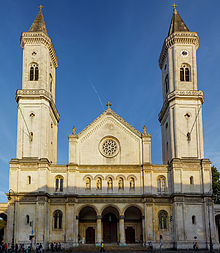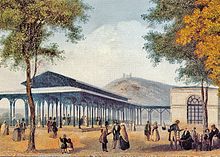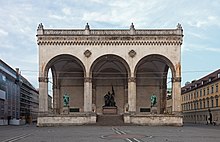Friedrich von Gärtner
Friedrich Wilhelm Gärtner , from 1837 Ritter von Gärtner , (born December 10, 1791 in Koblenz , † April 21, 1847 in Munich ) was a German architect . Along with Leo von Klenze , he is considered the most important master builder in the Kingdom of Bavaria under Ludwig I.
Life
Gärtner's parents were the architect Johann Andreas Gärtner (1744-1828) and his wife Barbara Sachs (1765-1818). His father was already involved in the construction of the Electoral Palace in Koblenz . In 1809 Friedrich von Gärtner studied at the Art Academy in Munich. In 1812 he moved to Paris and studied there until 1814. He then spent several years in Rome , Naples and Sicily . In 1819 he published his experiences and observations of this time in the annotated collection of lithographs Views of the most preserved monuments in Sicily . In the same year, Gärtner accepted a call to Munich as a professor of architecture at the art academy. In addition to his teaching subject, he was director of the Nymphenburg porcelain factory and glass painting company.
A decisive factor for his career as a building architect was his commissioning in 1827 to design a new building for the Bayerische Staatsbibliothek and the archive (today: Bayerische Staatsbibliothek ), which, however, could not begin until 1832. From that time on, Gärtner had the special confidence of the king, who also entrusted him with the decisive planning for the northern continuation of Ludwigstrasse in Munich. On the recommendation of Peter von Cornelius , Gärtner began building the Ludwigskirche in 1829 .
Appointed senior building officer and general inspector of the architectural and plastic art monuments of Bavaria, he took over the management of a number of public buildings. In 1840 he was ennobled and went to Athens with a retinue of builders and painters to complete and decorate the royal palace built according to his design. On his return he restored the cathedral in Bamberg, among other things . In 1842 he began building the Liberation Hall near Kelheim , but died before completion. The building was redesigned and completed by Leo von Klenze at the behest of the king . In 1842 he was appointed director of the Munich Academy . In the same year he began with the expansion of the old southern cemetery in Munich, which he designed with 175 arcades in the Italian style of a Campo Santo, as in Bologna.
Gärtner received the Knight's Cross of the Order of Merit of the Bavarian Crown in 1837 . Associated with this was the elevation into the personal nobility. He was also in command of the Order of the Redeemer and an officer of the Belgian Order of the Leopold .
tomb
Gärtner found his final resting place in the new part of the old southern cemetery in Munich, which he designed himself . In 1840, King Ludwig I gave Gärtner the order to expand what had been known as the Central Cemetery, the Old Southern Cemetery. Friedrich von Gärtner planned the expansion in the form of a Campo Santo, such as in Bologna , with 175 round arched arcades. As a gardener in 1847 died, one first buried in the crypt Karl Wilhelm von Heideck of the old southern cemetery in the old arcades (Old Arkadenplatz 35 at cemetery 23) location . On February 27, 1850, the "New Part" of the Old Southern Cemetery was consecrated. Gardener was reburied at the direction of King Ludwig I on the same day and buried the first in the new part of the old southern cemetery (New Arkadenplatz 175 at cemetery 29) location . The tomb comes from Friedrich Brugger

family
He married Katharina Heß (1798–1832) in Munich in 1822 and, after her death, in 1834 her sister Lambertine Heß (1804–1852). They were the daughters of the engraver and professor Carl Ernst Christoph Hess (1755–1828) and Marie Lambertine Katharine Krahe. From the first marriage there were two sons and a daughter:
- Friedrich (1824–1905), architecture and landscape painter
- Karl (1827–1894), painter
- Charlotte († 1909) ∞ Carl D'Herigoyen (1807–1875)
The second marriage had a son and a daughter, including:
- Wilhelmine (Minna) (born August 29, 1838 - † March 9, 1923) ∞ Adolf von Heinleth
Gardener's style
Typical of Gärtner's design intentions was the so-called round arch style , which processed the suggestions and motifs of the Romanesque style into a new synthesis and stood in clear creative and, in some cases, ideological contrast to the classicism style, which emphasized the vertical and horizontal. Its facades appear extremely monumental and thus corresponded to the ideas of Ludwig I, who wanted to transform Munich into a center of art and culture through lively building activity and to approximate his ideal of classicism . The round arch style also received great attention abroad (e.g. the USA). In Würzburg , Ludwig I had his court architect build the new main synagogue in the “Egyptian style” from 1837 to 1841 and thus thwarted the planned construction of the building by the Würzburg master builder Anton Eckert. Busts of gardeners can be found on the Gärtnerplatz named after him and in the Munich Hall of Fame .
buildings
- Ludwigskirche (1829–1844), Munich
- Restoration of the Isartor , Munich
- Ingenheim synagogue (1831–1832), Billigheim-Ingenheim
- Catholic parish church St. Ludwig in Karlshuld (1832–1835)
- Library and archive building (today the State Library) (1832–1842), Munich
- Institute for the Blind (1833–1835), Ludwigsstrasse, Munich
- Arcade construction with conversation room (1834–38), Bad Kissingen
- University building (1835–1840), Munich
- Herzogliches Georgianum (1835–1840), Prof.-Huber-Platz, Munich
- Educational institute for noble fräulein (original building of the Max-Joseph-Stifts ), Ludwigstrasse , today Prof.-Huber-Platz, Munich
- St. Anna Women's Foundation (1836–1839), Munich
- Official staff (administration building of the old salt works , 1836–1839), Bad Reichenhall
- Royal Castle (1836–1843), Athens (today: Parliament Building)
- Main synagogue at Domerschulstrasse 21 (1838–1841), Würzburg
- Salinenadministration (1838–1843), Munich
- Pompejanum (1839–1847 / 50), Aschaffenburg
- Old southern cemetery , in Munich (1840–1848), cemetery expansion in the style of a Campo Santo
- Feldherrnhalle (1841–1844), Munich
- Police building in Lohr am Main (1842, then hospital foundation, then regional and district court)
- Liberation Hall started in 1842, near Kelheim
- Wittelsbacher Palais (1843–1847/49), Munich
- Siegestor (1843–1847/52), Munich
- Evangelical Lutheran Church of the Redeemer (1847), Bad Kissingen
- Queen's Villa, Ludwigstrasse Munich
- Kurhaus, Bad Brückenau
- Town hall, Zwickau
- Jug magazine (Bad Kissingen) (1839)
- Fountain on Geschwister-Scholl-Platz
student
Belonged to Friedrich von Gärtner's students
- Max Emanuel Ainmiller
- Mathias Berger
- Franz Xaver Beyschlag
- Anton von Braunmühl
- Eduard Bürklein
- Friedrich Bürklein
- Lorenz Hoffmann
- Karl Friedrich Andreas Klumpp
- Karl Leimbach
- Amadeus Merian
- Eduard Metzger
- Johann Moninger
- Robert Moser
- Anton effort
- Carl Rothpletz
- Georg von Stengel
- August from Voit
bibliography
- Roman architectural decorations after antiquity . Munich 1824.
- Selection of vases and vessels, engraved on stone . Munich 1825.
- Friedrich von Gärtner's Original - Plans and Studies . Hans Moninger, self-published in Munich 1882.
literature
- Friedrich von Gärtner. An architect's life 1791–1847. With the letters to Johann Martin von Wagner . Exhibition catalog Münchner Stadtmuseum October 9, 1992 - January 10, 1993. Munich 1992 (the standard work on the subject)
- Hans Moninger: Friedrich von Gärtner's original plans and studies , [...] Munich 1882.
- Klaus Eggert: Friedrich von Gaertner. The builder of King Ludwig I , Munich 1963.
- Oswald Hederer: Friedrich von Gärtner 1792–1847. Life, work, pupil . Munich 1976.
- Carolyn Krebber: The building of the Bavarian State Library in Munich by Friedrich von Gärtner . Munich 1987.
- Friedrich Pecht : gardener, Friedrich Ritter von . In: Allgemeine Deutsche Biographie (ADB). Volume 8, Duncker & Humblot, Leipzig 1878, p. 380 f.
- Oswald Hederer: Gärtner, Johann Friedrich Ritter v .. In: New German Biography (NDB). Volume 6, Duncker & Humblot, Berlin 1964, ISBN 3-428-00187-7 , p. 21 f. ( Digitized version ).
- Christiane Rossner: The Orlando Furioso from Koblenz . In: Monuments. Magazine for Monument Culture in Germany 7/8 (2009), pp. 74–81.
Movie
- Friedrich von Gärtner - The builder of King Ludwig I of Bavaria. Documentary, Germany, 1992, 44:10 min., Script and direction: Dieter Wieland , production: Bayerischer Rundfunk , series: Topographie, synopsis by ARD .
Web links
- Literature by and about Friedrich von Gärtner in the catalog of the German National Library
- Collection of the designs of buildings by F. von Gärtner, vol .: 1/2, library and archive building in Munich, Munich, approx. 1845 (digitized version of the Bavarian State Library)
- Video at ARD-Alpha, 16 min. (Online until February 20, 2021) Stories of great spirits: Red carpet for art Leo von Klenze, Friedrich von Gärtner, Ferdinand Lang discuss on a stage in the old southern cemetery.
Individual evidence
- ↑ The tombstone in Munich's Alten Südfriedhof names the year of birth MDCCXCII, i.e. 1792.
- ↑ City of Koblenz: Famous Koblenzers: Friedrich von Gärtner , accessed on July 6, 2011.
- ^ Court and State Handbook of the Kingdom of Bavaria 1840, p. 23.
- ↑ Court and State Manual of the Kingdom of Bavaria 1846, p. 47.
- ↑ Court and State Manual of the Kingdom of Bavaria 1846, p. 42.
- ↑ Claudia Denk, John Ziesemer: “Grabstätte 163” in Art and Memoria, Der Alte Südliche Friedhof in Munich (2014), p. 468
- ↑ Ursula Gehring-Münzel: The Würzburg Jews from 1803 to the end of the First World War. In: Ulrich Wagner (Hrsg.): History of the city of Würzburg. Volume III / 1–2: From the transition to Bavaria to the 21st century. 2007, pp. 499-528 and 1306-1308, here: pp. 513 f.
- ↑ www.alemannia-judaica.de: On the history of the synagogues of the 19th and 20th centuries. Century .
| personal data | |
|---|---|
| SURNAME | Gardener, Friedrich von |
| ALTERNATIVE NAMES | Gardener, Friedrich Ritter von; Gardener, Johann Friedrich Ritter von (full name); Gärtner, Friedrich (until 1837); Gardener, Johann Friedrich (until 1837) |
| BRIEF DESCRIPTION | German architect and university professor |
| DATE OF BIRTH | December 10, 1791 |
| PLACE OF BIRTH | Koblenz |
| DATE OF DEATH | April 21, 1847 |
| Place of death | Munich |










